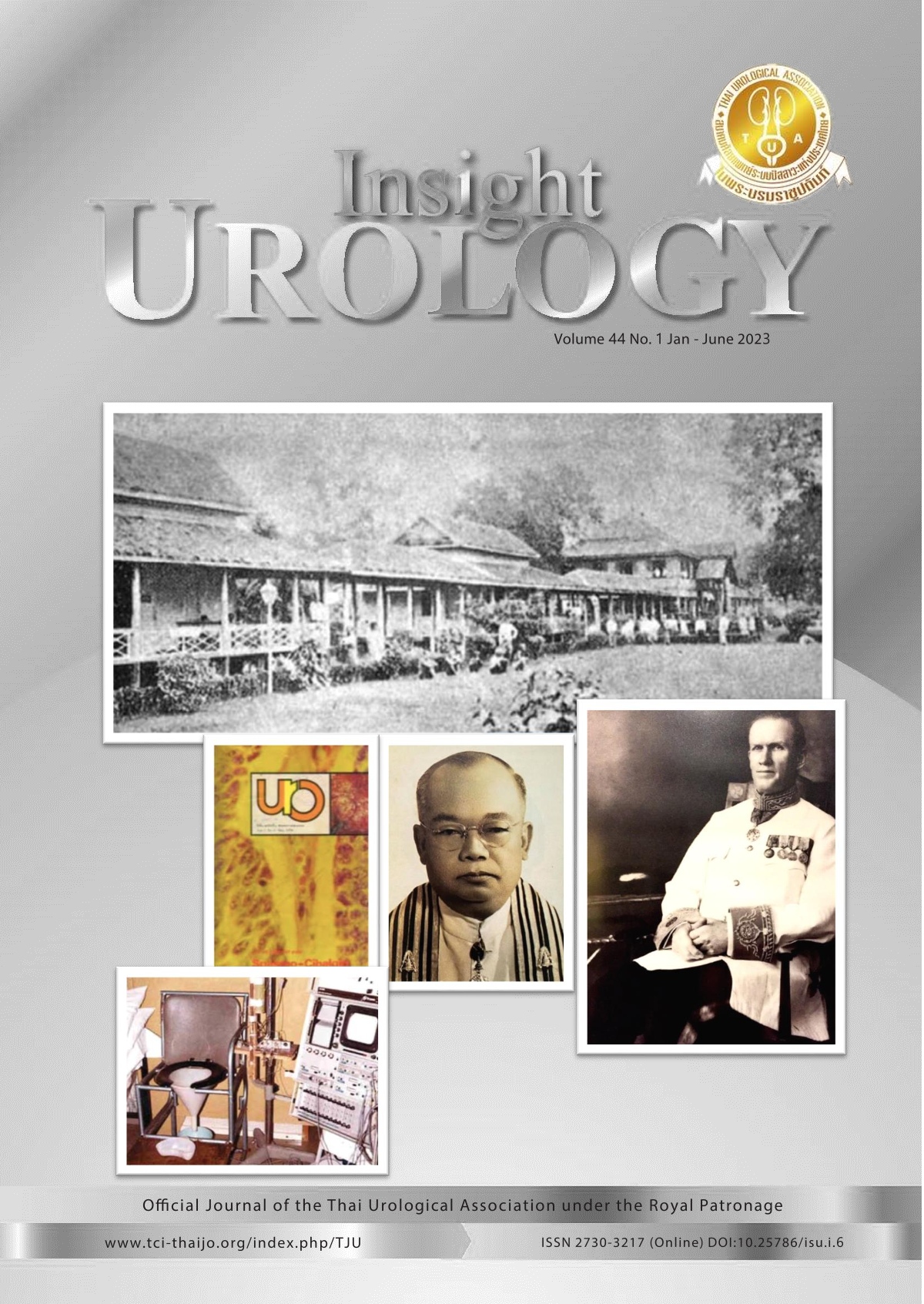Association between the levels of postoperative pyuria and urinary tract infection in patients undergoing Transurethral Anatomical Enucleation of Prostate (TUAEP) in Rajavithi Hospital
DOI:
https://doi.org/10.52786/isu.a.65Keywords:
Prostatic hyperplasia, Transurethral Anatomical Enucleation of Prostate, TUAEP, postoperative bacteriuriaAbstract
Objective: Pyuria is a common condition that can occur after TUAEP. One possible cause is postoperative inflammation. To limit this many physicians prescribe antibiotic prophylaxis to prevent postoperative urinary tract infections, however this can lead to the overuse of antibiotics and increase the growing problem of antibiotic resistance. Therefore the object of this study is to evaluate the association between the level of postoperative pyuria and urinary tract infections in patients undergoing TUAEP and to identify other risk factors associated with postoperative urinary tract infection facilitating appropriate antibiotic management.
Materials and Methods: Data from 94 patients who underwent TUAEP in Rajavithi Hospital from 1st December 2016 to 31st March 2021 were retrospectively analyzed. The data collected from medical records included demographic data, details from operative record sheets and laboratory results.
Results: A significant association was found between a level of postoperative pyuria >100 WBCs/HPF and postoperative bacteriuria (46.15% vs 19.35%, p = 0.024). Diabetes mellitus and preoperative bacteriuria were also significant risk factors for postoperative bacteriuria. The bacterium which was the most frequently cultured from samples taken both preoperatively and postoperatively was Escherichia coli.
Conclusion: The risk factors for postoperative bacteriuria in patients undergoing TUAEP are a level of postoperative pyuria > 100/HPF, diabetes mellitus and preoperative bacteriuria. It may be concluded from the results that the most frequent cause of postoperative pyuria was more likely to be due to a tissue reaction after surgery than from a urinary tract infection. Selective antibiotic treatment in patients who have these risk factors can reduce problems of antibiotic overuse and anti- biotic resistance.
References
Reich O, Gratzke C, Stief CG. Techniques and longterm results of surgical procedures for BPH. Eur Urol 2006;49:970-8.
Helo S, Welliver Jr RC, McVary KT. Minimally Invasive and Endoscopic Management of Benign Prostatic Hyperplasia. In: Partin AW, Dmochowski RR, Kavoussi LR, Peters CA, editors. Campbell- Walsh-Wein Urology. 12th ed. Philadelphia: Elsevier; 2020. p. 3437.
Mebust WK, Holtgrewe HL, Cockett AT, Peters PC. Transurethral prostatectomy: immediate and postoperative complications. A cooperative study of 13 participating institutions evaluating 3,885 patients. J Urol 1989;141:243-7.
Eaton AC, Francis RN. The provision of transurethral prostatectomy on a day-case basis using bipolar plasma kinetic technology. BJU Int 2002;89:534-7.
Botto H, Lebret T, Barre P, Orsoni JL, Herve JM, Lugagne PM. Electrovaporization of the prostate with the Gyrus device. J Endourol 2001;15:313-6.
Thaidumrong T, Duangkae S, Jiramanee V, Kalapong J, Pisansalhidikam P. Transurethral Anatomical Enucleation of Prostate (TUAEP) in Benign Prostatic Hyperplasia with Bipolar system : First study in Thailand. J Med Assoc Thai 2019;102:20-5.
Tuhkanen K, Heino A, Ala-Opas M. Two-year followup results of a prospective randomized trial comparing hybrid laser prostatectomy with TURP in the treatment of big benign prostates. Scand J Urol Nephrol 2001;35:200-4.
Souverein PC, van Riemsdijk MM, de la Rosette JJ, Opdam PC, Leufkens HG. Treatment of benign prostatic hyperplasia and occurrence of prostatic surgery and acute urinary retention: a population-based cohort study in the Netherlands. Eur Urol 2005;47:505-10.
Liu C, Zheng S, Li H, Xu K. Transurethral enucleation and resection of prostate in patients with benign prostatic hyperplasia by plasma kinetics. J Urol 2010;184:2440-5.
Neill MG, Gilling PJ, Kennett KM, Frampton CM, Westenberg AM, Fraundorfer MR, et al. Randomized trial comparing holmium laser enucleation of prostate with plasmakinetic enucleation of prostate for treatment of benign prostatic hyperplasia. Urology 2006;68:1020-4.
Yoshikazu T, Koji F, Yasuo U, Sojun K, Yosuke S, Koichiro W, et al. Comparison of single- and multiple-dose cefazolin as prophylaxis for transurethral enucleation of prostate: A multicenter, prospective, randomized controlled trial by the Japanese Re- search Group for Urinary Tract Infection. Int J Urol 2020; 27:244-8.
Xiong W, Sun M, Ran Q, Chen F, Du Y, Dou K. Learn- ing curve for bipolar transurethral enucleation and resection of the prostate in saline for symptomatic benign prostatic hyperplasia: experience in the first 100 consecutive patients. Urol Int 2013;90:68-74.
Roehrborn CG, Strand DW. Benign Prostatic Hyperplasia: Etiology, Pathophysiology, Epidemiology, and Natural History. In: Partin AW, Dmochowski RR, Kavoussi LR, Peters CA, editors. Campbell-Walsh- Wein Urology. 12th ed. Philadelphia: Elsevier; 2020.p. 3305.
Cooper KL, Badalato GM, Rutman MP. Infection of the Urinary Tract. In: Partin AW, Dmochowski RR, Kavoussi LR, Peters CA, editors. Campbell-Walsh-Wein Urology. 12th ed. Philadelphia: Elsevier; 2020. p. 1129.
Zhang KY, Xing JC, Chen BS, Liu CX, Lau HW, Sim HG, et al. Bipolar plasmakinetic transurethral resection of the prostate vs. transurethral enucleation and resection of the prostate: pre-and postoperative comparisons of parameters used in assessing benign prostatic enlargement. Singapore Med J 2011;52:747-51.
Nicolle LE, Bradley S, Colgan R, Rice JC, Schaeffer A, Hooton TM, et al. Infectious diseases society of America guidelines for the diagnosis and treatment of asymptomatic bacteriuria in adults. Clin Infect Dis 2005;40:643-54.
Downloads
Published
How to Cite
Issue
Section
License
Copyright (c) 2023 Insight Urology

This work is licensed under a Creative Commons Attribution-NonCommercial-NoDerivatives 4.0 International License.



